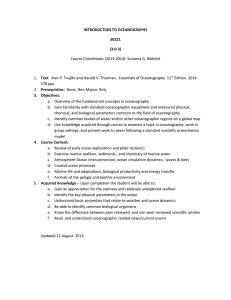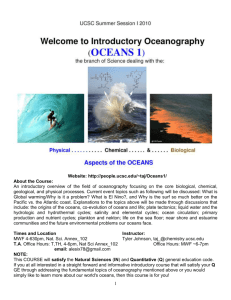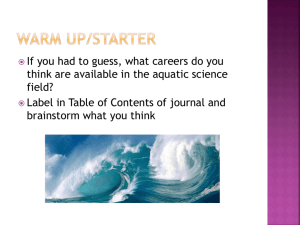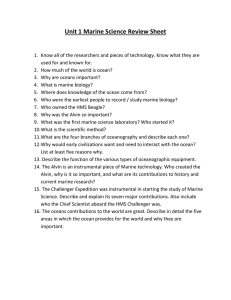2008.06 - Oceanography (OCN) 201L: Science of the Sea Lab, Course Outline and Grid
advertisement
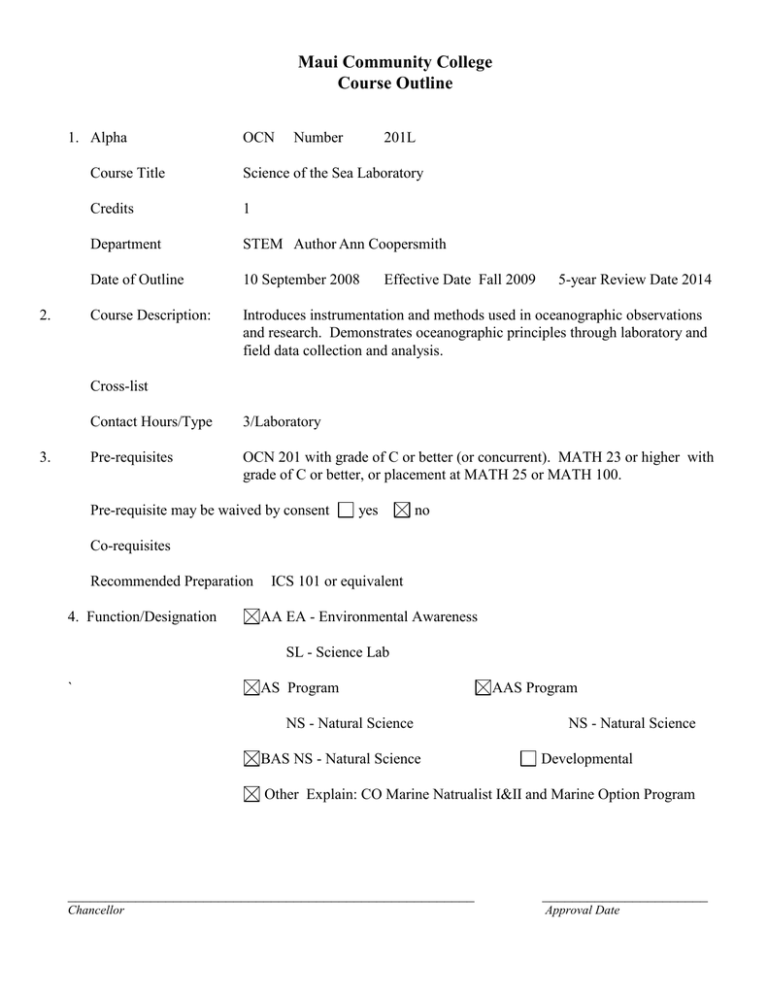
Maui Community College Course Outline 1. Alpha 2. OCN Number 201L Course Title Science of the Sea Laboratory Credits 1 Department STEM Author Ann Coopersmith Date of Outline 10 September 2008 Course Description: Introduces instrumentation and methods used in oceanographic observations and research. Demonstrates oceanographic principles through laboratory and field data collection and analysis. Effective Date Fall 2009 5-year Review Date 2014 Cross-list 3. Contact Hours/Type 3/Laboratory Pre-requisites OCN 201 with grade of C or better (or concurrent). MATH 23 or higher with grade of C or better, or placement at MATH 25 or MATH 100. Pre-requisite may be waived by consent yes no Co-requisites Recommended Preparation 4. Function/Designation ICS 101 or equivalent AA EA - Environmental Awareness SL - Science Lab ` AS Program NS - Natural Science BAS NS - Natural Science AAS Program NS - Natural Science Developmental Other Explain: CO Marine Natrualist I&II and Marine Option Program ______________________________________________________ ______________________ Chancellor Approval Date See Curriculum Action Request (CAR) form for the college-wide general education and/or program SLOS this course supports. 5. Student Learning Outcomes (SLO): List one to four inclusive SLOs. For assessment, link these to #7. Recommended Course Content & Approximate Time Spent on Each Topic and #9. Suggested Course Requirements & Evaluation. Use roman numerals (I., II. III.) to designate SLOs On successful completion of this course, students will be able to: I. explain the basic concepts and principles of oceanography; II. demonstrate the use of standard oceanographic equipment, explain the data collection protocol, and the importance of the data collected by each; III. design and carry out an experiment including observation, developing a question and hypothesis, and data collection and analysis. 6. Competencies/Concepts/Issues/Skills and/or PLO For assessment, link these to #7. Recommended Course Content & Approximate Time Spent on Each Topic and #9. Suggested Course Requirements & Evaluation. Use lower case letters (a., b., c…n.)to designate competencies/concepts/skills/issues On successful completion of this course, students will be able to: a. explain and demonstrate use of navigation aids including: marine charts, maps, geographic positioning systems and geographical information systems (GPS/GIS), and celestial and instrument navigation; b. demonstrate correct use of instruments and interpret data collected for water depth, various water quality parameters, surface currents, light and sound in the ocean, planktonic marine organisms; c. demonstrate methods for accessing data and resources from internet for oceanic water quality, solar radiation, ocean productivity, weather, waves and swells, GIS mapping, and various tracking data; d. explain the principles and give illustrations and/or examples of the geological origin of the ocean, seafloor spreading, and plate tectonics; marine sedimentation; ocean circulation and relationship to climate, weather, and severe weather; causes and effects of ocean waves; primary and secondary productivity; differences between ocean ecosystems; adaptations of marine organisms to different habitats; and e. explain the causes and effects of local and global environmental changes on the ocean. 7. Suggested Course Content & Approximate Time Spent on Each Topic Linked to #5. Student Learning Outcomes and # 6 Competencies/Concepts/Issues/Skills 1-2 weeks 1-2 weeks 1-2 weeks 1 week 1 week 1-2 weeks experiment: design, data collection, results, and reports (I,II,III,a,b,c,d,e) geography of the ocean, marine charts, maps, navigation aids, GPS/GIS, celestial and instrument navigation (I,II,a,d) sea floor spreading, plate tectonics, bathymetry, techniques for determining depth, marine sediments (I,II,b,c,d) water quality: salinity, temperature, dissolved oxygen, carbon dioxide, pH, alkalinity, nitrates, phosphates, silicates; nutrient cycles; Hawai’i ocean observing system (HiOOS), primary & secondary productivity (I,II,b,c,e) ocean water circulation: surface currents, water masses, and deep circulation (I,II,b,c,d) severe weather (storms, hurricanes), El Nino Southern Oscillation (ENSO), satellite tracking (I,II,b,c,d,e) 1-2 weeks 1-2 weeks 1-2 weeks 1-2 weeks 1-2 weeks open ocean waves, shallow water waves, beach erosion; tides: causes, prediction, variations (I,II,c,d) light and sound in the ocean (I,II,b,e) distribution of marine life, marine ecosystems, adaptations (I,II,c,d,e) plankton sampling and identification (I,II,b,c,d,e) marine debris, water pollution, global warming, ocean acidification (I,II,c,e) 8. Text and Materials, Reference Materials, and Auxiliary Materials Appropriate text(s) and materials will be chosen at the time the course is offered from those currently available in the field. Examples include: Pipkin, Bernard F., Donn S. Gorsline, Richard E. Casey, Dean Dunn, and Stephen A. Schellenberg. 2000. Laboratory Exercises in Oceanography, 3rd edition, WH Freeman, San Francisco. Morris, Kalon W., 2005. Introduction to Oceanography Lab Manual, 2nd edition, Kendall Hunt, Dubuque, Iowa. Appropriate reference materials will be chosen at the time the course is offered from those currently available in the field. Examples include: local navigational charts and maps and manuals for scientific field and lab equipment. Appropriate auxiliary materials will be chosen at the time the course is offered from those currently available in the field. Examples include: ArcGIS software and instructions and Zooplankton Methodology Manual by Roger Harris, Peter Wiebe, Jurgen Lenz, and Hein-Rune Skjoldal. 9. Suggested Course Requirements & Evaluation Linked to #5. Student Learning Outcomes (SLOs) and #6 Competencies/Concepts/Skills/Issues Specific course requirements are at the discretion of the instructor at the time the course is being offered. Suggested requirements might include, but are not limited to 10 –50% 0–30% 0 –30% 0–20% 0–20% 30–50% 10–20% 0–20% examinations including written quizzes, midterm(s), and/or a final covering discussions, media presentations, lab activities, field trips, guest speakers, and reading assignments (I,II,a,b,c,d,e); lab practical exams (I,II,a,b,c,d,e); reading and writing summaries and/or reactions to articles concerning oceanaographic issues [includes newspapers, broadcast video, CD-ROMs, DVDs, magazines, journals, lectures, web-based material, etc.] (I,II,a,b,c,d,e); reading assigned text materials, notes, and/or answering discussion questions (I,II,a,b,c,d,e); participation in class discussions, and group or individual oral reports (I,II,III,a,b,c,d,e); laboratory and/or field skills, experiments, and activities (I,II,a,b,c,d,e); experiment [making observations, stating a problem, asking a question, formulating a hypothesis, designing and carrying out procedure to test the hypothesis, collecting and analyzing data, and writing a report that includes an abstract, introduction, materials and methods, data tables, charts, graphs, data analysis, discussion of results, conclusion and summary, references and work cited] (I,II,III,a,b,c,d,e); projects, reports, civic engagement activities, and/or Service-Learning (I, II,a,b,c,d,e); and 8–10% punctuality, attendance, and participation (I,II,III,a,b,c,d,e). 10. Methods of Instruction Instructional methods will vary considerably by instructor. Specific methods are at the discretion of the instructor teaching the course and might include, but are not limited to a. exams and quizzes with feedback and discussion; b. field and lab practical exams; c. demonstrations and class discussions; d. problem solving; e. narrated PowerPoint presentations; f. videos, DVDs, CD-ROMs with detailed viewing guides and discussion questions; g. lab activities including reports, experiments, lab skill lessons, data collection and analysis, and other activities; h. field trips including field notes, activities, observations, and data collection; i. guest speakers and attendance at public lectures; j. group activities; k. oral reports and other student presentations; l. games and simulations; m. homework assignments such as - reading appropriate materials related to oceanography, such as magazines, journals, webpages, and other sources, and watching television programs, videos, DVD; - reading text and reference materials and answering discussion questions; - researching environmental issues and problems; n. web-based assignments and activities; o. reflective journals; p. group and/ or individual research projects with reports or poster presentations; q. study logs and study groups; r. Service-Learning, community service, and/or civic engagement projects; and s. other contemporary learning techniques (such as problem-based learning, investigative case-based learning, co-op, internships, self-paced programs, etc.) 11. Assessment of Intended Student Learning Outcomes Standards Grid attached Assessment of Intended Student Learning Outcomes Standards Key: 3 = Major Emphasis: The student is actively involved (uses, reinforces, applies, and evaluated) in the student learning outcomes. The learner outcome is the f 2 = Moderate Emphasis: The student uses, reinforces, applies and is evaluated by this learner outcome, but it is not the focus of the class 1 = Minor Emphasis: The student is provided an opportunity to use, reinforce, and apply this learner outcome but does not get evaluated on this learner outco 0 = No Emphasis: The student does not address this learner outcome OCN 201L Standard 1 - Written Communication Write effectively to convey ideas that meet the needs of specific audiences and purposes. Outcome 1.1 - Use writing to discover and articulate ideas. 2 Outcome 1.2 - Identify and analyze the audience and purpose for any intended communication. 2 Outcome 1.3 - Choose language, style, and organization appropriate to particular purposes and audiences. 2 Outcome 1.4 - Gather information and document sources appropriately. 3 Outcome 1.5 - Express a main idea as a thesis, hypothesis, or other appropriate statement. 3 Outcome 1.6 - Develop a main idea clearly and concisely with appropriate content. 2 Outcome 1.7 - Demonstrate a mastery of the conventions of writing, including grammar, spelling, and mechanics. 2 Outcome 1.8 - Demonstrate proficiency in revision and editing. 2 Outcome 1.9 - Develop a personal voice in written communication. 1 Standard 2 - Quantitative Reasoning Synthesize and articulate information using appropriate mathematical methods to solve problems of quantative reasoning accurately and appropriately. Outcome 2.1 - Apply numeric, graphic, and symbolic skills and other forms of quantitative reasoning accurately and appropriately. 3 Outcome 2.2 - Demonstrate mastery of mathematical concepts, skills, and applications, using technology when appropriate. 2 Outcome 2.3 - Communicate clearly and concisely the methods and results of quantitative problem solving. 2 Outcome 2.4 - Formulate and test hypotheses using numerical experimentation. 3 Outcome 2.5 - Define quantitative issues and problems, gather relevant information, analyze that information, and present results. 3 Outcome 2.6 - Assess the validity of statistical conclusions. 1 Standard 3 - Information Retrieval and Technology Access, evaluate, and utilize information effectively, ethically, and responsibly. Outcome 3.1 - Use print and electronic information technology ethically and responsibly. 2 Outcome 3.2 - Demonstrate knowledge of basic vocabulary, concepts, and operations of information retrieval and technology. 2 Outcome 3.3 - Recognize, identify, and define an information need. 2 Outcome 3.4 - Access and retrieve information through print and electronic media, evaluating the accuracy and authenticity of that information. 2 Outcome 3.5 - Create, manage, organize, and communicate information through electronic media. 1 Outcome 3.6 - Recognize changing technologies and make informed choices about their appropriateness and use. 2 Standard 4 - Oral Communication Practice ethical and responsible oral communications appropriately to a variety of audiences and purposes. Outcome 4.1 - Identify and analyze the audience and purpose of any intended communication. 1 Outcome 4.2 - Gather, evaluate, select, and organize information for the communication. 2 Outcome 4.3 - Use language, techniques, and strategies appropriate to the audience and occasion. 2 Outcome 4.4 - Speak clearly and confidently, using the voice, volume, tone, and articulation appropriate to the audience and occasion. 2 Outcome 4.5 - Summarize, analyze, and evaluate oral communications and ask coherent questions as needed. 1 Outcome 4.6 - Use competent oral expression to initiate and sustain discussions. 1 Standard 5 - Critical Thinking Apply critical thinking skills to effectively address the challenges and solve problems. Outcome 5.1 - Identify and state problems, issues, arguments, and questions contained in a body of information. 2 Outcome 5.2 - Identify and analyze assumptions and underlying points of view relating to an issue or problem. 2 Outcome 5.3 - Formulate research questions that require descriptive and explanatory analyses. 3 Outcome 5.4 - Recognize and understand multiple modes of inquiry, including investigative methods based on observation and analysis. 3 Outcome 5.5 - Evaluate a problem, distinguishing between relevant and irrelevant facts, opinions, assumptions, issues, values, and biases through the use of appropriate evidence. 3 Outcome 5.6 - Apply problem-solving techniques and skills, including the rules of logic and logical sequence. 3 Outcome 5.7 - Synthesize information from various sources, drawing appropriate conclusions. 2 Outcome 5.8 - Communicate clearly and concisely the methods and results of logical reasoning. 2 Outcome 5.9 - Reflect upon and evaluate their thought processes, value system, and world views in comparison to those of others. 2 Standard 6 - Creativity Program graduates are able to express originality through a variety of forms. 1

